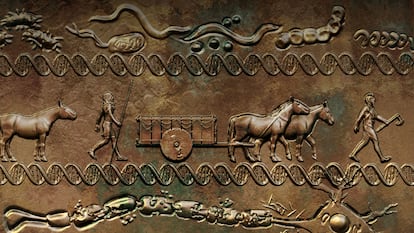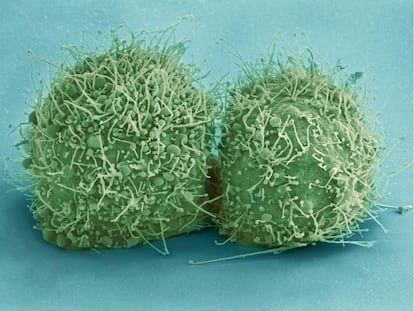Prehistoric migrations explain Europeans’ propensity to suffer from sclerosis, Alzheimer’s and diabetes
The genetic analysis of thousands of human remains from the Neolithic and Mesolithic explains how mutations that protected the first shepherds also predisposed them to suffer from autoimmune diseases

Prehistoric times are, to a great extent, a mystery. No written records were left behind, just ruins, dust and bones. But events large and small were registered inside those bones, which tell stories that humanity only learned to read around 10 years ago, when modern genome sequencing techniques started to get off the ground. It was then that scientists from Copenhagen University began investigating the genetic material of 1,600 human remains from northern and western Eurasia, chiefly from the Neolithic and Mesolithic periods. These researchers embarked on a titanic project that has crystallized this Wednesday with the publication of four studies in Nature magazine. “We were often surprised,” said the authors. “And we are sure that there are many more surprises waiting to be uncovered.” Their results provide information about European history over the last 15,000 years and underscore how the migrations of the past explain who modern Europeans are and why they become ill. Genetics has opened a window into a remote and unknown past that sheds light on the present.
We already knew that today’s Europeans have up to 80% more chances of developing multiple sclerosis than Asian people. And that northern Europeans are more likely to develop this autoimmune disease of the nervous system than southern Europeans. Now we also know why. This propensity began to take shape around 5,000 years ago, with the arrival on the continent of pastoralists from the Pontic-Caspian steppe, an area covering parts of modern-day Ukraine, southern Russia and the border of Kazakhstan. It is believed that genetic variants associated with sclerosis provided these shepherds with an immunological advantage at a time of rising infectious diseases caused by direct and prolonged contact with their herds.
“It is a really nice example of how lifestyle changes can increase or reduce the risk of getting sick or even introduce new pathogens,” said Astrid Iversen, a professor of virology at Oxford University, during a virtual presentation of the findings. “Our lifestyle has changed thanks to hygiene, we are less in contact with animals and we see fewer benefits in these variants, which can trigger autoimmune responses, but it’s important to realize that this is something new, from the last 200 years.”
The same genes that began protecting us from new diseases millennia ago have been working against us for a few decades. But we could surmise that in the future, if the environment does not change, these mutations will be gradually discarded to adapt to the new reality. “One of the things we have seen is that genes related to the immune system are selected depending on the pathogens the latter has to deal with; genetic variations depend on the ecosystem,” said the virologist. This idea, she acknowledged, has already been considered in the past. “But it had not been demonstrated in such a clear way as we saw it; we have solid evidence.”
Another analysis tracked the genetic variations associated with the risk of diabetes and Alzheimer’s, and concluded that they are related with the rise of Western hunters-gatherers. Once again, this genetic mutation that has negative effects in the present made some sense in the past from an evolutionary standpoint. “The combination of genes that make you more prone to suffer from Alzheimer’s also has protective effects during pregnancy,” said Iversen. “There is an enormous advantage, especially in populations where many children die young and where life expectancy is not very high, so that Alzheimer’s would not have much of an impact.”
It is not possible to treat a condition without knowing where it comes from, and these studies provide a very clear idea of the origin of these diseases, said Rasmus Nielsen, a biologist who teaches at Berkeley University, at the presentation. The analysis, he explained, evidences that genetic evolution means accepting a certain balance: “There are mutations that could provide protection in one environment and be negative in others. This gives us a global vision that could demystify the origin of these diseases.”
Why southern Europeans are shorter
The genetic study also explains more trivial but equally interesting issues. The average height of a man in Spain is 176 cm (5′7 ft) while in The Netherlands it is 184 (6 ft). These differences between northern and southern Europe are well known, but thanks to this analysis we now know that they began to take shape thousands of years ago. They seem to be associated with differential steppe origins, rather than selection or current nutrition habits. The study also underscores how the human genome changed with changes in our diet and the adoption of agriculture. The interesting part, said the experts, is not so much what is revealed about our past, but how we can put it in context with today’s genetic maps.
“In these we see these differences between northern and southern Europe, between eastern and western Europe,” said Carles Lalueza-Fox, a geneticist at Spain’s National Research Council (CSIC) who participated in the study, in a telephone conversation. “But we are unable to know how far back they go, or understand why they occurred.” Having a temporal gene scale lets scientists do that. If until now we had photographs, now we have added earlier scenes to create a movie. “In recent years, we have been reconstructing migrations. But now, thanks to them, we are finding an explanation of the origins of disease.”
It is thought that three great migrations shaped the genetic diversity of modern populations in Western Eurasia: the emergence of hunters-gatherers around 45,000 years ago, the expansion of Middle East farmers from the Neolithic around 11,000 years ago, and the rise of steppe shepherds around 5,000 years ago. “These three major ancestralities have different gene frequencies that create a propensity for certain diseases,” said Lalueza-Fox. “You can see them and compare them.” The study compared the ancient genome with the genome of around 410,000 white Europeans from today’s United Kingdom, and were able to quantify the proportion of genetic material from these prehistoric groups in modern Europeans, and their impact on certain diseases.
The geneticist highlighted that the strong point of this research is the fact that whole genome sequencing was conducted. “Most work genotypes a million variable positions on the genome, out of which you get half. That’s enough to conduct population genetics,” he said. “But in this case they sequenced the entire genome, which gives them more of an ability to track trends.”
The weakest part of the study is due to an archeological limitation. DNA is better preserved in cold climates, especially if thousands of years have gone by. “There is a clear bias towards northern regions because very few samples have been preserved in southern Europe,” laments this expert. In fact, one of the four studies focused exclusively on Denmark, where it analyzed demographic, cultural and nutritional changes of the population during prehistoric times.
In any case, this study adds 1,600 prehistoric genomes to a database that already exceeds 10,000. “And in a few years that figure is going to double,” said Lalueza-Fox. “This is exponential progression, limited only by the number of available individuals.” The race to unveil the history of prehistory involves archeological sites containing remains thousands of years old and modern laboratories. Tools of the past and technologies of the future are coming together to unlock stories that were never written on paper but inside our bones.
Sign up for our weekly newsletter to get more English-language news coverage from EL PAÍS USA Edition
Tu suscripción se está usando en otro dispositivo
¿Quieres añadir otro usuario a tu suscripción?
Si continúas leyendo en este dispositivo, no se podrá leer en el otro.
FlechaTu suscripción se está usando en otro dispositivo y solo puedes acceder a EL PAÍS desde un dispositivo a la vez.
Si quieres compartir tu cuenta, cambia tu suscripción a la modalidad Premium, así podrás añadir otro usuario. Cada uno accederá con su propia cuenta de email, lo que os permitirá personalizar vuestra experiencia en EL PAÍS.
¿Tienes una suscripción de empresa? Accede aquí para contratar más cuentas.
En el caso de no saber quién está usando tu cuenta, te recomendamos cambiar tu contraseña aquí.
Si decides continuar compartiendo tu cuenta, este mensaje se mostrará en tu dispositivo y en el de la otra persona que está usando tu cuenta de forma indefinida, afectando a tu experiencia de lectura. Puedes consultar aquí los términos y condiciones de la suscripción digital.
More information
Últimas noticias
Most viewed
- Reinhard Genzel, Nobel laureate in physics: ‘One-minute videos will never give you the truth’
- Oona Chaplin: ‘I told James Cameron that I was living in a treehouse and starting a permaculture project with a friend’
- Pablo Escobar’s hippos: A serious environmental problem, 40 years on
- Charles Dubouloz, mountaineering star, retires at 36 with a farewell tour inspired by Walter Bonatti
- Why we lost the habit of sleeping in two segments and how that changed our sense of time











































